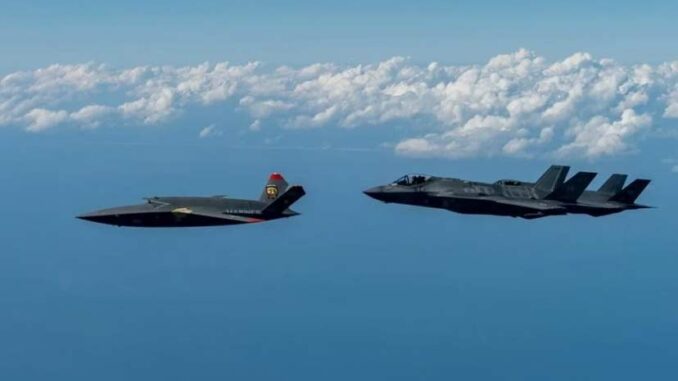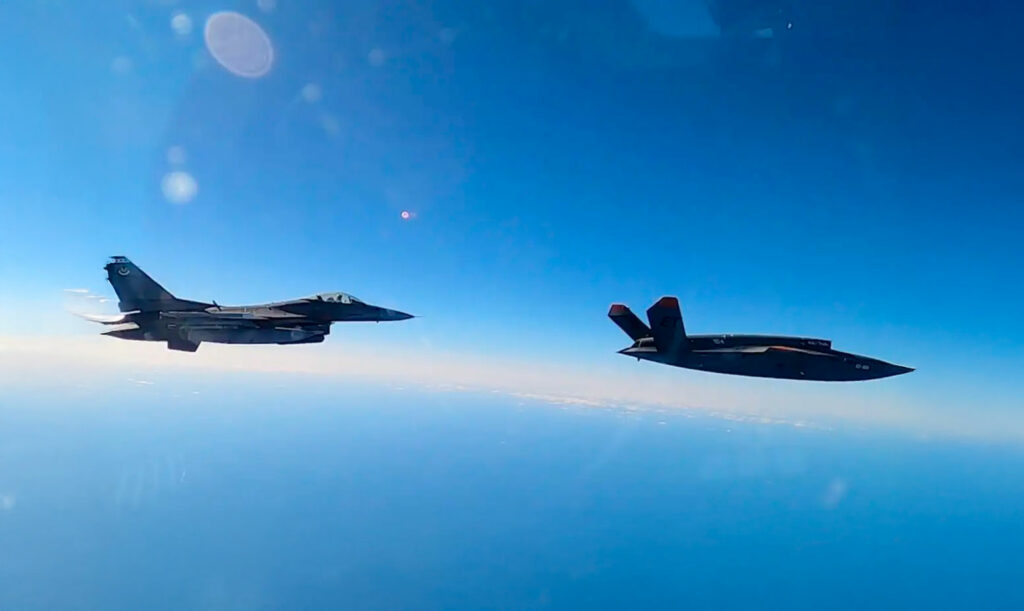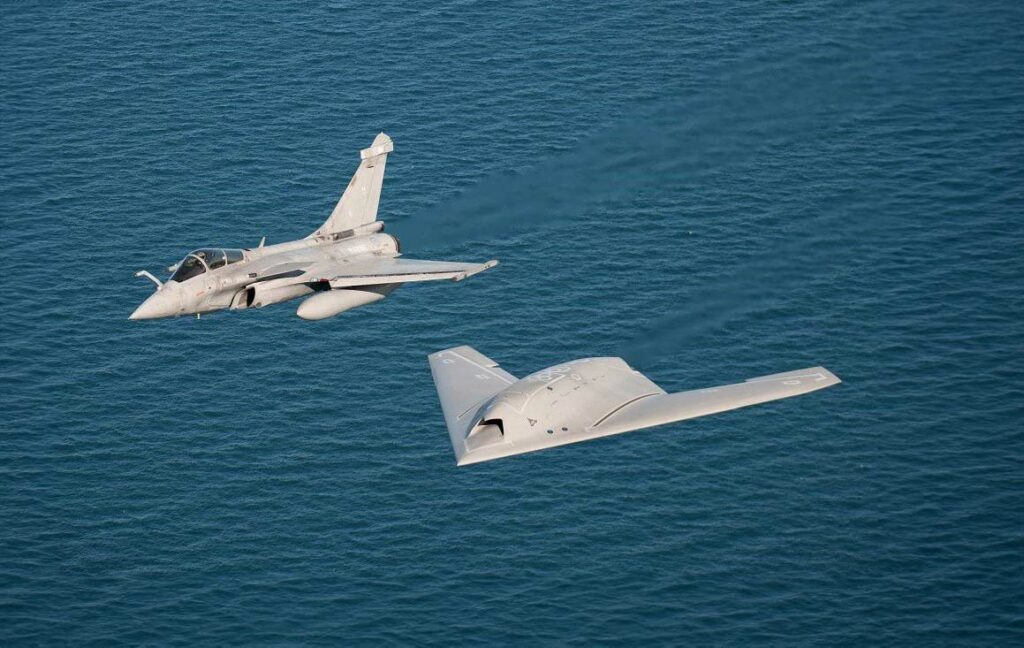
Fighter jets and tactical drones now form integrated teams. Find out how, why, and with what technologies these synchronized attacks are carried out.
In summary
Fighter-attack operations are evolving: fighter jets now coordinate with tactical drones to target, monitor, and strike with greater precision and less risk. The concept known as Manned-Unmanned Teaming (MUM-T) refers to all of these human-machine synergies. Tactical drones such as the XQ-58A Valkyrie or the MQ-28 Ghost Bat fulfill a variety of roles: advanced reconnaissance, jamming, strike support, or “loyal wingman” squadron. Fighter jets—such as the F-35 Lightning II, F-16 Fighting Falcon, and F-15E Strike Eagle—rely on these drones to improve their situational awareness, save time, and increase their firepower. This coordination requires ultra-fast data links, sensor-to-sensor sharing, and new tactical procedures. However, limitations remain: dependence on links, vulnerability of drones, and complexity of integration with heterogeneous platforms. In this article, we will first explore the concept and its typical drones, then communication technologies, then roles and missions, and finally the advantages but also the limitations and the place of the fighter pilot in this system.
The concept of coordinated attack between fighters and tactical drones
The concept, often referred to as Manned-Unmanned Teaming (MUM-T), refers to the simultaneous and integrated use of manned (fighter aircraft) and unmanned (tactical drones) platforms to carry out offensive or air superiority missions.
The idea is to take advantage of their respective strengths: the tactical flexibility and quick decision-making of a human pilot, reduced risk for the crew thanks to exposed drones, and multiple sensors and actions in the theater. Aircraft hunt, strike, or ensure superiority, while tactical drones can lead the way, jam, monitor, or even launch the first munitions. This human-machine duo is profoundly changing traditional air doctrines centered solely on fighter jets.
In practice, a fighter jet can lead a squadron of loyal wingman or tactical drones as the attack leader. The pilot coordinates the formation, trajectory, and engagement, and each drone performs specific assigned tasks. In a recent exercise, an F-16 or F-15 pilot controlled two XQ-58A Valkyries in flight in the United States.
This example illustrates that integration is indeed underway and no longer purely theoretical.

Tactical drones in use and their operational profiles
The tactical drones used in coordination with fighter jets are varied. They can be classified according to their role, range, control mode, and location relative to the manned aircraft.
Examples of drones
- The XQ-58A Valkyrie (Kratos): a low-cost, subsonic (approximately Mach 0.75 to 0.9) “loyal wingman” tactical drone designed to be controlled by a manned aircraft. It provides reconnaissance, fire support, or decoy capabilities.
- The MQ-28 Ghost Bat (Boeing Australia): designed to operate in formation with fighter aircraft such as the F-35A, with the ability to carry air-to-air or air-to-surface munitions and act as an autonomous “wingman.”
- Other “loyal wingman” drones or UCAVs (Unmanned Combat Aerial Vehicles) are under development to accompany the next generation of fighters (sixth generation).
Mission profiles
These drones can:
- Position themselves ahead of the formation for reconnaissance (target identification, passive sensors, radar detection);
- Conduct jamming or electronic warfare to prepare for fighter attacks;
- serve as decoys or bait to attract enemy defenses;
- carry out a direct attack, under supervision, against ground or air targets;
- relay data or links for fighters, acting as communication nodes in contested environments.
For example, during the test mentioned above, F-16 and F-15 pilots each controlled two Valkyries in an air combat scenario. The drones acted as autonomous wingmen and as capability multipliers.
Communication and aircraft-drone integration technologies
The success of coordinated aircraft-drone attacks relies on a highly sophisticated set of technologies. Here are the main components.
Data links
Data links enable real-time data exchange between aircraft, tactical drones, command platforms, and potentially satellites. The NATO STANAG 4586 standard describes the levels of interoperability for integrating drones with aircraft.
In tests, it appears that pilots control drones via a cockpit interface or associated screens, from which they can issue tactical or autonomous commands.
Sensor fusion and situational awareness sharing
Fifth-generation fighter aircraft such as the F-35 already feature sensor fusion (AESA radar, IRST, DAS, etc.). When drones are integrated, they provide additional sensors—electro-optical imaging, passive sensors, ESM/ELINT—and this data is fused to create enhanced situational awareness. The aircraft then acts as a central node, while the drones extend the field of observation.
Autonomy and embedded algorithms
Some drones are remotely piloted, others are semi-autonomous or even autonomous. Recent tests show that piloted aircraft can control semi-autonomous drones in flight.
Autonomy allows drones to perform subtasks (e.g., flying in formation, maintaining course, monitoring an area) while the pilot focuses on the main mission. This division of tasks is essential for reducing cognitive load.
The pilot-drone interface
The fighter pilot receives a specific display and controls to manage the escort or drone team. Some demonstrations mention the use of a tablet in the cockpit to guide multiple drones.
The pilot can assign tasks: “go and monitor this corridor,” “jam this radar,” “attack this target when I give the green light.” Piloting remains human for decision-making, with autonomy for execution.
The advantages of aircraft-drone coordination for attacks
The integration of tactical drones with fighter jets offers many advantages:
Extended range and coverage
Drones can operate in front of, below, or behind the fighter formation, extending the range of observation and engagement. The aircraft can remain at a distance, while the drone enters a more risky area. This allows attack or reconnaissance corridors to be opened without exposing the crew.
Multiplication of sensors and speed of decision-making
With drones dedicated to surveillance, electronic warfare, or reconnaissance, fighter jets receive an enriched data stream. This reduces the “decision-making time” (OODA loop) and allows for more precise strikes. The pilot can view data from multiple drones, identify the target, and engage with a higher level of information.
Reduced risk to the crew
Drones can be exposed in the engagement zone, absorb fire, or perform dangerous functions, while the fighter remains in the background. This improves the survivability of the primary platform.
Tactical flexibility and dispersion
An aircraft-drone formation can disperse: the drone can go ahead, the aircraft can follow behind, and then the roles can be reversed. This flexibility complicates the enemy’s defense. In addition, multiple drones can be used to saturate or divert defenses, while the aircraft carries the main ammunition.
Cost optimization
Tactical drones are often less expensive to produce and operate than fighter aircraft. Combining them with fighters creates a “multiplier effect” with less expensive units. This allows for a denser air force.
Different coordinated attack missions
Here are some typical scenarios in which aircraft-drone coordination is used:
Air superiority mission
A fighter jet takes off in formation with two drones ahead of it. The drones locate enemy interceptors, jam their radars, and wait for the order to engage. The fighter jet then strikes with air-to-air missiles.
Ground strike mission
The drone advances in reconnaissance mode, tags the target, measures radar emissions, or locates air defenses. It transmits the coordinates to the aircraft, which moves into attack position. The drone can also jam or neutralize certain defenses while the aircraft fires guided munitions.
Electronic warfare and suppression of air defenses (SEAD)
The drones enter the defended area, detect and locate surface-to-air missile (SAM) systems. They can launch decoys, jam or execute strikes. Meanwhile, the aircraft or other drones take advantage of this opening to attack.
Reconnaissance and dynamic fire support
During combat, the pilot can receive live images from a drone positioned in a blind spot. The drone tracks a moving target, transmits it to the aircraft, and then the attack is carried out in a matter of seconds.
The role of the fighter pilot in an aircraft-drone system
The pilot remains the tactical leader of the engagement. Here are his key responsibilities:
Advance planning
Before the flight, the pilot participates in mission planning: choosing roles (who leads, who escorts, who monitors), trajectories, rendezvous points, altitudes, and engagement orders. He integrates tactical drones, their roles, and constraints.
In-flight management
During the mission, the pilot monitors the status of the drones, reads data streams, and assigns dynamic tasks. He can redeploy a drone, ask it to change course, or assign it a new mission. He retains final control over firing or striking.
Decision-making and engagement
When the target is identified, the pilot orders the engagement. He can order the drone to attack or fire himself. He also decides on evasion or repositioning maneuvers.
Supervision of drone logistics
The pilot must monitor the drones’ fuel or range, their data link, their return or replacement. They must anticipate the loss of a drone or a break in the link and adapt the mission accordingly.
Synergy with the extended crew
In two-seater aircraft (e.g., F-15E) or in squadrons, the pilot works with the navigator/weapons officer, electronic warfare operators, and also with the ground-based drone controller or command room operator. The pilot coordinates everything like an orchestra conductor.
The limitations, dependencies, and challenges of aircraft-drone coordination
Although promising, this approach has several vulnerabilities and constraints:
Dependence on data links
If the link between the aircraft and the drone is cut (jamming, cyberattack, enemy action), the system loses its effectiveness. The drone may also lose contact with other sensors or air force networks.
Increased vulnerability of drones
Tactical drones may be less well protected, less stealthy, or more easily destroyed. Their loss can reduce the coverage or role of the aircraft. Choosing an “attritable” (inexpensive) drone mitigates the risk, but the factor remains.
Complexity of integration and tactical consistency
Combining drones and aircraft of various models, often with heterogeneous software, sensors, and links, poses a significant complexity. Synchronization, ergonomics for the pilot, and system reliability must be guaranteed.
Cognitive load for the pilot
In addition to their piloting and combat roles, pilots now find themselves managing the drone team. This increases their mental load. A clear interface and automation are necessary to avoid overload.
Logistics and maintenance
Each drone adds to the need for maintenance, spare parts, ground operators, and technical support. If a large number of drones are deployed, logistics becomes a limiting factor.
Contested engagement scenarios
In a highly contested environment (advanced air defenses, intensive jamming, cyberattacks), aircraft-drone coordination can be disrupted. The adversary can target links or drones to disrupt the attack.

Upcoming technologies and expected developments
Several avenues are visible for strengthening this coordination:
- The transition to more autonomous drones, capable of carrying out sub-missions without direct command. This will reduce the load on the pilot.
- The development of robust “loyal wingman” or UCAV platforms, capable of flying with fighters and executing strikes or decoys.
- Increased integration of “combat cloud” networks: data sharing between aircraft, drones, satellites, and land and sea sensors.
- The deployment of interoperable standards to enable different types of aircraft and drones to cooperate easily.
- The introduction of on-board artificial intelligence to supervise drones, optimize trajectories, and free the pilot from secondary tasks.
Coordination that redefines air attack
By combining fighter jets and tactical drones, air forces gain a major advantage: human-machine synergy. The pilot remains at the heart of the decision-making process, but is now supported by a network of tactical drones that provide eyes, information, and sometimes firepower. This coordination increases engagement density, improves strike speed, and opens up new tactical possibilities. Technological and logistical challenges must still be overcome before this practice becomes standard operating procedure.
War Wings Daily is an independant magazine.